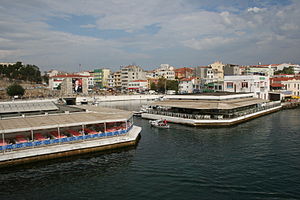Gelibolu, also known as Gallipoli, is a town in Eastern Thrace, on the northern banks of the Straits of Dardanelles.
- For the national park housing battlefields and related monuments of Gallipoli Campaign of World War I, see the separate Gallipoli article.
Understand
Gelibolu, ancient Kallipolis (Greek for "beautiful city"), from which both modern Turkish and English (Gallipoli) names derive, is located at the base of the peninsula named after the town, which juts out from Thracian mainland and extends for about 50 km in a northeast-southwest direction between the Straits of Dardanelles and the Gulf of Saros, an inlet of Aegean Sea. From Gelibolu eastwards, the Straits widen into the Sea of Marmara.
The site of the earliest Ottoman shipyards and navy headquarters, Gelibolu has always been a seafaring town, once serving as the capital of the Ottoman province that occupied most of the Aegean islands, all the way down to Crete. Perhaps the most famous native of the town was Piri Reis, an Ottoman admiral and cartographer, known primarily for the quite accurate map of American continent he had drawn in 1513.
Today, due to its strategic locality, Gelibolu is a garrison town, with a substantial part of its surface area consisting of military camps. As of 2011, it has a population of more than 30,000.
Get in

Gelibolu lies 2 km south of the highway between Eceabat (which has ferry connections to Çanakkale) and Keşan (D550/E87), where the highway connects with D110/E84 to east (Istanbul), D110/E90 to west (Greek border) and D550/E87 to north (Edirne). Two connecting roads lead into the town centre.
All buses operating on the Istanbul–Çanakkale route drive into town's small otogar, which lies about 5 minutes walk west of town centre.
Quite frequent ferries connect Gelibolu with the towns of Çardak and Lapseki—which lie about 15 km away from each other—across the Dardanelles on the Asian mainland. However, as this is where the strait is at its widest, crossing takes no less than 45 minutes. The ferry jetty in Gelibolu is right on the edge of the town square.
Get around
See
Despite its current provincial feel, Gelibolu is quite rich in historical sights.
Do
Buy
Eat
Drink
Sleep
You can find some hotels at the central square next to the ferry jetty, as well as some more behind the Hamzakoy beach northeast of town centre.
Connect
Telephone code of the town is (+90) 286.
Go next
- You may possibly want to visit Gallipoli battlefields and WWI memorials next, but those are located at the opposite tip of the peninsula, i.e., about 45 km southwest of Gelibolu. As such, Eceabat and Çanakkale are more convenient hubs for a visit there.
- About 15 km northeast of Gelibolu, just off the highway to Keşan is the village of Bolayır, up on the hilly spine of the peninsula. Bolayır is the site of cemeteries of Süleyman Pasha, the Ottoman commandant who captured more or less what is today Turkish Thrace from Byzantines in 14th century, and Namık Kemal, the national poet of Turkey who hold republican ideals during the decline of Ottoman Empire in late 19th century. Despite the occupants' historical importance, the cemeteries are not very impressive edifices, but basic Ottoman-style tombs (the outdoor marble sarcophagi with Ottoman/Arabic carvings all around them—including Namık Kemal's own—may worth the look, though), however they are located in a large attractive garden with a commanding view of the farmlands below. Also near Bolayır is the ruins of the first Ottoman Turkish foothold on European mainland, taken by Süleyman Pasha in 1350s—the originally Byzantine Çimpe/Tzympe Castle (2 km southwest of Bolayır along the former highway, past the cemetery. This abandoned road only very partially retains its original surface material and is full of potholes, so best not to be attempted by a low-clearance car. No public transport to the site). While what is left of the castle is architecturally not very remarkable and mostly of reconstructions dating back to 19th century, it, unsurprisingly for a medieval castle, occupies the highest hill around and has views of both the Gulf of Saros (Aegean Sea) to north, and the Sea of Marmara to south. Despite the historical significance of the site, it's the feeling of desolation that reigns here most, and it is very likely that you will be the only visitor of the place (free of charge).
- Çardak to south across the Dardanelles is a sea-side resort town with campgrounds and numerous beaches.
| Routes through Gelibolu |
| Kırklareli ← Keşan ← | N |
→ Gallipoli National Park entrance → Çanakkale |
